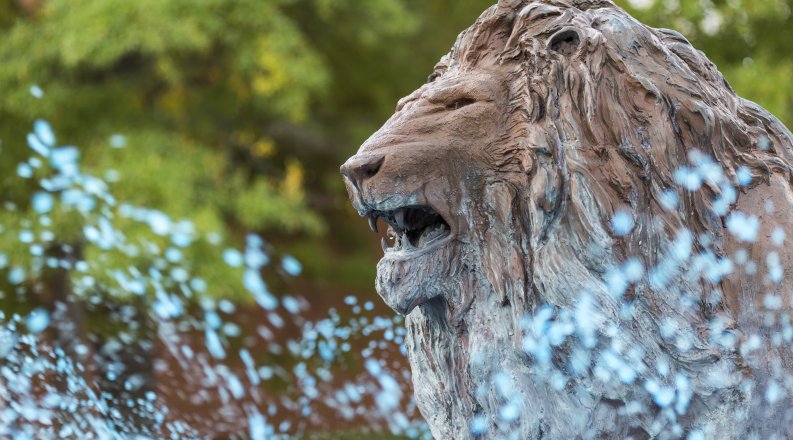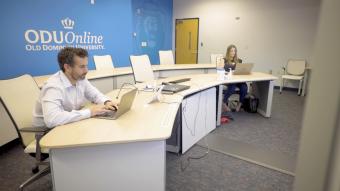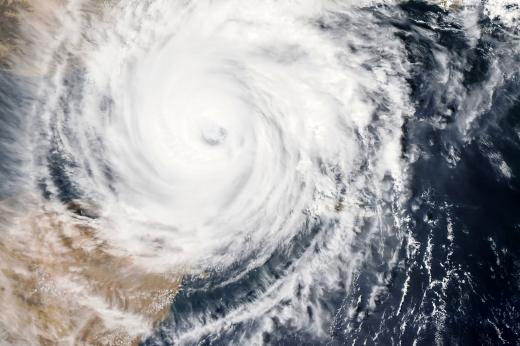By Harry Minium
As with so many important events during the pandemic, Old Dominion University was forced to cancel a weeklong program last spring called High Achieving Latinxs in Engineering and Science (HALES).
The HALES project is designed to increase the representation of Hispanics in science, technology, engineering and math (STEM) disciplines. ODU planned to bring 10 students from Puerto Rico and 10 from Virginia to be immersed in science.
The weeklong trip was to include lectures from leading experts, discussions and behind-the-scenes field trips at ODU and through the University's partnerships with NASA Langley and the Thomas Jefferson National Accelerator Facility (Jefferson Lab).
After canceling the event, the HALES steering committee was brainstorming what it might do to replace the HALES in-person experience when Giovanna Genard made a recommendation.
Genard, ODU's assistant vice president for strategic communication and marketing, recommended they create a virtual STEM-based program that delivered that experience to people in their homes.
That's when light bulbs went off on the Zoom screen.
That idea led to months of work involving more than 100 ODU staff members that eventually produced ODU's first global virtual science and engineering program.
Called the Remote Experience for Young Engineers and Scientists (REYES), the program produced 81 live lectures on scientific topics that reached 7,335 people in 115 countries. Lectures were held for eight weeks with at least one topic covered every day.
To put that in perspective, the 7,335 participants would nearly fill ODU's Chartway Arena, and the program reached two-thirds of the world's 195 countries, from Brazil to Spain and Germany, to India, China and Pakistan.
"We all thought it was going to be an alternative to HALES, but it turned out to be so much more than that," said Raul Briceño, an assistant physics professor at ODU and staff scientist with the Jefferson Lab. "We never thought it would reach this many people."
Genard and Briceño, who co-chaired the REYES committee, met daily for four months to create and run the program, and also met weekly with the REYES team.
When they began their work, they expected the HALES participants, plus several hundred students, would be interested in enrolling in a series of summer STEM lectures.
And that's when they mobilized and put together a star-studded lineup.
The Jefferson Lab, NASA, the European Organization for Nuclear Research (CERN), the Mexican Space Agency, the College of William & Mary, Huntington Ingalls Industries, the Berkeley Lab in California and ARIO, a high-tech company based in Norfolk, all contributed. So did the National Autonomous University of Mexico (UNAM), which with 360,000 students is the largest university in the Americas.
"Through the REYES virtual program, we aimed to inspire students so they can see themselves in future STEM roles and be the next generation of problem-solvers, inventors and high-tech entrepreneurs," Genard said.
Professors from a variety of STEM disciplines, from biology to engineering, agreed to take part. In all, 77 experts, the vast majority from ODU, delivered presentations.
"When we reached out to people, no one said no," said Orlando Ayala, associate professor of mechanical engineering technology and a REYES team member. "Everyone wanted to help."
Genard, meanwhile, pulled a few strings. In 2019 and 2020, Genard, a native of Puerto Rico, visited nine Latin American embassies in Washington to help expand ODU's brand globally to increase collaboration between the University and Latin American countries.
When she contacted the Mexican Embassy this spring to promote REYES, her contacts reached out to colleges, high schools and every Mexican consulate in Mexico and the United States to let students know that ODU was offering a free STEM program over the summer.
"We had 2,100 students from Mexico participate," Briceño said, and that almost matched the 2,500 from the United States.
As registration for the summer program ballooned past 1,000, and then past 3,000, then past 5,000, ODU realized it had another problem. Its Zoom license would not allow that many students online at once.
So ODUOnline and the University IT staff created a new platform for REYES that would allow thousands to be online at once, but also insured the privacy of participants.
All 81 presentations have been preserved online, as have presentation slides from most of the lectures. Professors from UNAM and volunteers from other universities in Mexico agreed to translate all videos into Spanish. That should be completed this fall.
The presentations are being transferred to YouTube as well. All REYES videos are available free of charge.
REYES took advantage of the ODUOnline staff and created dynamic presentations to make the sessions interactive with live questions from students. In some classes, chatrooms facilitated problem solving by students.
Topics ran the gamut from those of interest to just about anyone to those of interest only to those truly schooled in science.
The first week featured introductory courses designed to attract students into sciences. Then courses became progressively more complicated.
There was "How we can make hydrogen from water: Forget fossil fuels" by Alvin Holder, a chemistry and biochemistry associate professor, and "Einstein, Black Holes and the Cosmic Tango" by Balša Terzić, an associate professor in physics.
If you listened to "Patterns of Immigration in the United States" from Alan Meca, assistant professor of psychology, you learned, among other things, of his life as a second-generation Cuban immigrant growing up in Miami. He often was chided for not speaking English well enough by longtime Americans - and by family and neighbors for not speaking Spanish well enough.
Assimilating to American culture, Meca showed through research as well as his own experience, is stressful to immigrants and their offspring.
Another presentation from Deborah Waller, "Solving Crimes by Using Forensic Entomology," showed how insects can help homicide detectives, in this case, a fictional murder in which the type of flies found on a body in a remote area indicated the date of a person's death.
Andrew Dotson, an ODU physics graduate and doctoral student at New Mexico State who is a YouTube star with more than 160,000 followers, hosted two trivia nights.
Genard said one contestant who won trivia night kept whispering into his microphone. "We had trouble hearing him," she said. "Turns out he was from India, where it was 1 a.m., and he did not want to wake his family."
All of the work, thousands of hours in total, was done on a volunteer basis.
"We all do this because it's fulfilling work," Meca said. "Being able to inspire the next generation of science students in way that's equitable is why we were all so passionate about this. We wanted to bring science from the ivory tower into the homes of the next generation of young scientists."
Ayala said Briceño was perhaps the most tireless lecturer. Briceño took part in or narrated 12 physics presentations and helped with presentations in other disciplines.
"I remember him saying so many times that taking care of a problem was going to be 'easy,' and for him it was," Ayala said.
Briceño said he had a "selfish" reason for working so hard, although it was anything but selfish.
"I wish something like this had existed when I was younger," he said. "I could see myself in the shoes of these students. I know there are thousands, perhaps millions of people who wish they had the same opportunity.
"I think we as a society benefit by making science available to as many people as possible because we're going to inevitably bring remarkably bright minds into the conversation who might be able to solve future problems in ways that you wouldn't think possible."
Because it was so successful, the REYES program has continued into the fall, with presentations scheduled on Oct. 16 and Nov. 19.
Planning for REYES in the summer of 2021 is also under way and the HALES project, assuming the pandemic is under control, will return next spring.
"HALES offers gifted students a chance to have experiences they would never have anywhere else," Ayala said. "We definitely want to continue that project."
Meca said eventually that REYES will pay dividends for ODU. More than 1,500 participants agreed to take a survey. Most international participants said they had never heard of the University and most said they are now more likely to consider seeking an ODU degree.
"We are putting ODU on the map," he said. "We're really making ODU a name that future young scientists will recognize.
"Whether they decide to attend ODU, we'll have to wait and see. The benefits likely won't be immediate. They will be in the long term.
"Sometimes the benefits aren't even with the people you reach. It's with the sibling who heard about the program from a sibling who took part or the community that heard about ODU."
Briceño said the benefit to students is the primary driving force for him.
"More than 66% of our participants felt more enthusiasm in pursuing careers in STEM or conductive research," he said. "As faculty, we are interested in bringing students to ODU, and we have built long-term connections with Mexico.
"But as humanists, it's in our interest to inspire people to become scientists, and REYES does that."
ODU professors remain in touch with many of the students they met online during REYES. Some are seeking advice on what courses to take to prepare for a science career.
Genard and Meca walked into their offices recently and found gifts on their desks - stainless steel water/coffee bottles from a REYES student who preferred to remain anonymous but left a short note.
"Words are powerless to express my gratitude for donating your time and expertise for the REYES program at ODU," the student wrote to Meca.
When he posted about the gift on Twitter, Meca wrote that had it not been for mentors, "I would not be who or where I am today.
"This letter and a gift from a participant mean the world to me."







